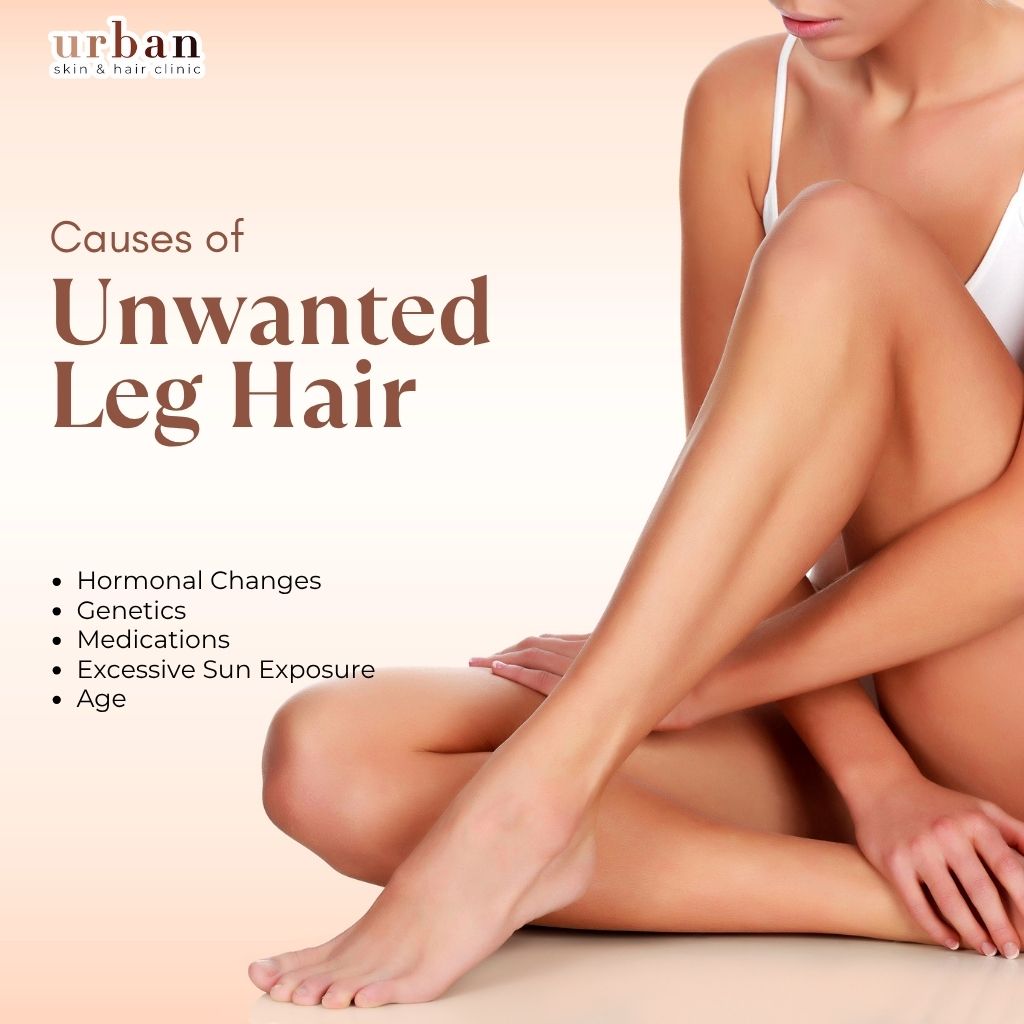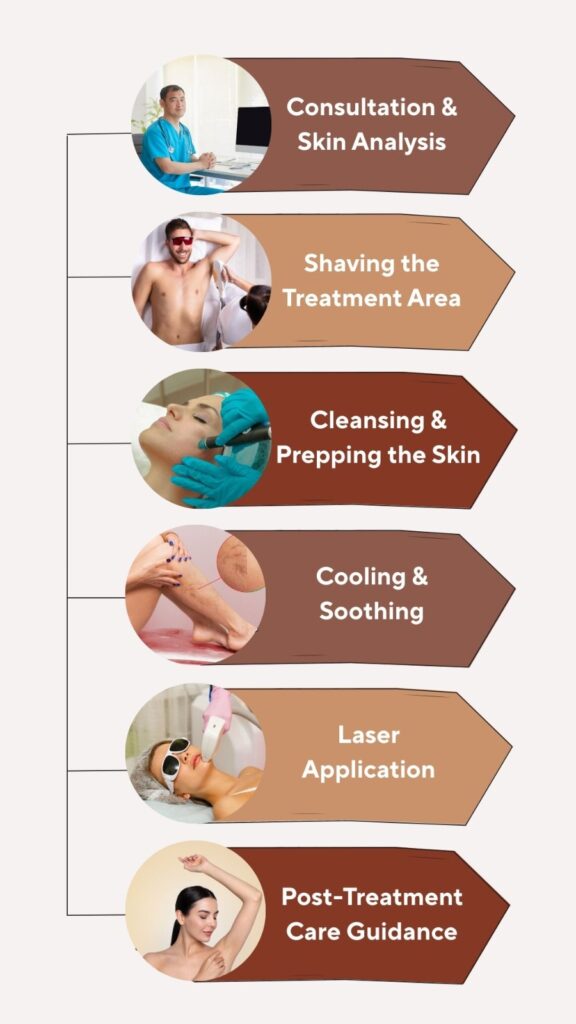
Smooth, Hair-Free & Confident Skin with Laser Hair Removal
Unwanted hair on the upper lip is a common cosmetic concern that can affect confidence and facial aesthetics. At Urban Skin and Hair Clinic, our advanced upper lip laser hair removal solutions are designed to target hair follicles at the root, reduce regrowth, and provide long-lasting smoothness. Using state-of-the-art laser technology, we deliver precise, safe, and effective treatments for all skin types, ensuring minimal discomfort and downtime. With expert dermatologists and customised care plans, we help you achieve a silky, hair-free upper lip and boost confidence with a cleaner, more refined appearance.
Introduction
Tired of the constant hassle of shaving or waxing your legs? At Urban Skin and Hair Clinic, we offer Laser Hair Removal for Legs, a safe, effective, and long-lasting solution to unwanted leg hair. Our advanced technology ensures a smooth, hair-free look, eliminating the need for frequent shaving or painful waxing, and providing you with silky skin all year round.
Leg hair removal with laser uses high-energy light to target and destroy the hair follicles in the legs. The laser energy is absorbed by the pigment in the hair, which prevents future hair growth. Laser hair removal is effective for large areas like the legs, providing long-lasting smoothness with minimal downtime.
What Causes Unwanted Hair Growth?
Unwanted hair growth occurs when hormonal imbalances, genetics, or certain medical conditions trigger excess hair production in areas like the face, arms, or body. Elevated levels of androgens (male hormones), often seen in conditions like PCOS (Polycystic Ovary Syndrome), can cause coarse, dark hair growth in women. Other contributors include stress, certain medications, obesity, and hereditary factors, which may disrupt normal hormone function.

Excessive or unwanted hair growth on the legs can result from various factors:
- Hormonal Changes: Fluctuations in hormones due to PCOS, pregnancy, menopause, or puberty can cause increased hair growth on the legs.
- Genetics: Family history plays a role in hair growth patterns. If your relatives have thicker body hair, you might experience similar hair growth.
- Age: Hormonal changes with age can lead to the development of thicker, more coarse leg hair.
- Medications: Certain medications, particularly those that alter hormonal balance, can trigger excessive leg hair growth.
- Excessive Sun Exposure: Sun exposure can darken the pigment of leg hair, making it appear thicker and more visible.
Benefits of Laser Hair Removal
Laser hair removal provides long-lasting smoothness by targeting hair follicles at the root, reducing regrowth, and preventing irritation, ingrown hairs, and razor bumps. It saves time compared to shaving or waxing, improves skin texture, and boosts confidence with soft, hair-free skin.
- Provides long-lasting hair reduction for smooth, hair-free skin.
- Saves time and effort compared to regular shaving, waxing, or threading.
- Reduces ingrown hairs, irritation, and razor bumps.
- Suitable for all body areas, including upper lip, underarms, arms, legs, back, and bikini line.
- Improves skin texture and leaves skin feeling soft and smooth.
- Precise targeting ensures effective results without damaging surrounding skin.
- Safe and minimally invasive with minimal downtime.
- Reduces hair regrowth over time, making maintenance easier.
- Boosts confidence and comfort in daily life.
- Customisable for all skin types and hair textures.

LHR Treatment Procedure
Step 1: Detailed Consultation & Skin Analysis: The dermatologist evaluates your skin type, hair density, medical history, and treatment goals to customise the laser settings.
Step 2: Pre-Treatment Skin Preparation: The treatment area is cleaned, shaved if necessary, and prepped for optimal laser effectiveness.
Step 3: Patch Test: A small area is tested to ensure skin tolerance and determine the safest laser intensity.
Step 4: Cooling & Soothing:
Cooling gels or advanced cooling devices are applied to protect the skin and reduce discomfort during the laser session.
Step 5: Laser Treatment:
The laser device is carefully applied over the targeted areas, delivering controlled energy to the hair follicles while preserving surrounding skin.
Step 6: Post-Treatment Care & Follow-Up:
Patients receive personalised aftercare instructions, including sun protection, soothing creams, and scheduled follow-ups for optimal long-term results.
Pre and Post Treatment Care
Pre-Treatment Care
- Avoid sun exposure and tanning for at least 2 weeks before treatment.
- Shave the treatment area 24 hours prior; do not wax, pluck, or use hair removal creams.
- Avoid applying perfumes, deodorants, or lotions on the treatment day.
- Inform your dermatologist about any medications, skin conditions, or recent procedures.
- Keep the skin clean and free from makeup or oils before your session.
Post-Treatment Care
- Apply soothing gels or moisturisers as recommended to calm the skin.
- Avoid direct sun exposure and always use broad-spectrum sunscreen on treated areas.
- Do not wax, pluck, or use hair removal creams between sessions.
- Avoid hot showers, steam, saunas, or vigorous workouts for 24–48 hours.
- Follow-up with scheduled sessions and maintain a gentle skincare routine for best results.
How Treatment Cost Is Decided?
The cost of any treatment depends on several key factors that determine the type, intensity, and number of procedures required. Since every patient’s condition, goals, and expectations are different, the final pricing is customised to ensure safe, effective, and personalised care.
- Severity of the Condition
- Type of Treatment Recommended
- Number of Sessions Required
- Technology & Equipment Used
- Doctor’s Expertise & Clinic Standard
- Customisation of the Treatment Plan
- Area/Extent of Treatment
Get An Appointment

Why Urban Skin and Hair Clinic

TEAM OF CERTIFIED DERMATOLOGISTS

US-FDA APPROVED EQUIPMENTS

HIGHLY STANDARDISED PROTOCOLS

1 LAKH + HAPPY CLIENTS
FAQ for Leg Hair Removal Treatment
Typically, 6-8 sessions are required for optimal results, with each session spaced several weeks apart. The number of sessions may vary depending on hair thickness and skin type.
Laser hair removal is relatively painless. You may feel mild discomfort during the treatment, but it’s significantly less painful than waxing or shaving.
Yes, the Diode Laser technology used for leg hair removal is safe and effective for all skin types, including sensitive skin.
Side effects are rare but may include mild redness or swelling, which usually resolves within a few hours after the procedure.
Yes, shaving is safe after laser hair removal. However, avoid waxing or plucking, as they can disrupt the effectiveness of the treatment.
Consult a Specialist Today
Dr. Kiran Chotaliya, M.D. Dermatology, is an expert in autoimmune hair loss treatments, including Alopecia Areata. With a compassionate approach and extensive clinical experience, Dr. Kiran will guide you through every step of the treatment process to ensure the best possible outcome.










